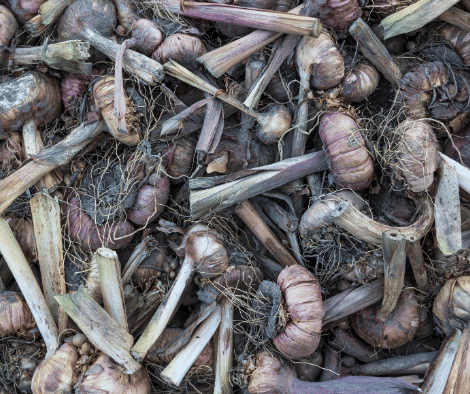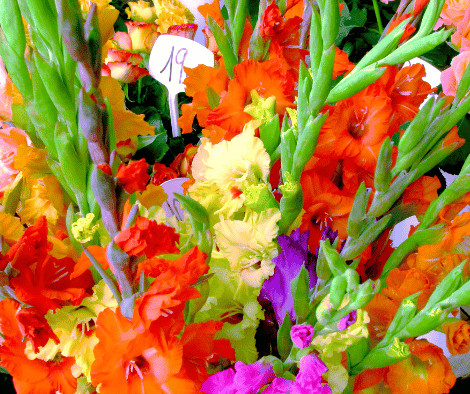Gladiolus Sword Lily, revered for its striking beauty and towering spikes of vibrant blooms, holds a special place in the hearts of gardeners and flower enthusiasts alike. In this detailed guide, we unravel the essence of gladiolus, exploring its meaning, scientific identity, ideal growing conditions, cultivation methods, essential care tips, seed extraction techniques, and the myriad reasons why cultivating this exquisite flower can elevate your garden to new heights of splendor.
What is Gladiolus?
Gladiolus, derived from the Latin word “gladius” meaning sword, is a genus of flowering plants belonging to the family Iridaceae. Scientifically known as Gladiolus, these magnificent blooms are renowned for their sword-shaped leaves and towering flower spikes adorned with multiple florets in an array of captivating colors.
Gladiolus, popularly called sword lily, takes its name from the Latin word Gladius because of sword shaped leaves. While other names are Aunt Eliza Rat’s Rail, Gladiola, Glads.The common/english name for gladiolus in India is Lily.
The Gladiolus Grandiflorus, affectionately referred to as “Glad,” dates back its origins to South Africa. This prominent bulbous cut flower plant, often dubbed the “Queen of the Bulbous Flowers,” stands out as one of the most beloved ornamental plants among gardeners.
Recommended Varieties Of Gladiolus
Gladiolus flowers offer a diverse array of sizes and colors, with the most sought-after varieties often belonging to the following hybrid groups:
- ‘Traderhorn’: This variety features striking red flowers with white centers, adding a bold pop of color to any garden or bouquet.
- ‘Flevo Cool’: Known for its elegant lavender blooms with ruffled edges, ‘Flevo Cool’ adds a touch of sophistication to flower beds and arrangements.
- ‘Peter Pears’: With its vibrant orange flowers and contrasting red markings, ‘Peter Pears’ creates a captivating focal point in the garden.
- ‘Black Jack’: A unique variety with deep purple-black flowers, ‘Black Jack’ adds drama and intrigue to floral displays.
- ‘White Prosperity’: For a classic and elegant look, consider ‘White Prosperity,’ featuring pristine white flowers that complement any color scheme.
- ‘Green Star’: Stand out from the crowd with ‘Green Star,’ which boasts striking lime-green flowers that make a bold statement in bouquets and borders.
- ‘Boone’: With its delicate pink petals and contrasting deep pink throat, ‘Boone’ adds a soft and romantic touch to garden beds and arrangements.
- ‘Atom’: This compact variety features fiery red flowers with a contrasting white center, perfect for adding a splash of color to smaller garden spaces or containers.
- ‘Purple Flora’: ‘Purple Flora’ offers stunning purple blooms with delicate white markings, creating a captivating display in any garden setting.
- ‘Nova Lux’: With its vibrant yellow flowers and contrasting red markings, ‘Nova Lux’ brings a burst of sunshine to gardens and floral arrangements.
When to Grow Gladiolus
Gladiolus plants grow from corms/bulb, which are underground storage organs similar to bulbs. These corms store nutrients and energy, allowing the plant to survive dormant periods and produce new growth when conditions are favorable.
Gladiolus corms are typically planted in the spring, once the soil has warmed up and all danger of frost has passed. For continuous blooming throughout the summer, stagger planting times every few weeks until mid-summer.
Gladiolus Flowering Season
Gladiolus blooms from mid-summer to early fall, gracing the garden with its spectacular floral display. With proper care and maintenance, gladiolus plants can produce multiple flower spikes, each boasting a profusion of blossoms in a kaleidoscope of hues.
Gladiolus blooms hold significant symbolism, often representing traits such as strength of character, faithfulness, moral integrity, and remembrance. They are notably the traditional flower for 40th wedding anniversaries and serve as the birth flower for the month of August.
Ways to Grow Gladiolus/Sword Lily
- Gladiolus can be grown from bulbs or corms, either directly in the garden or in containers.
- Choose a sunny location with well-drained soil for optimal growth.
- Plant bulbs at a depth of about 4-6 inches and space them 6-8 inches apart.
Care Requirements For Gladiolus/Sword Lily
- Soil: Plant gladiolus in fertile, well-drained soil with a slightly acidic to neutral pH.
- Watering: Keep the soil consistently moist but not waterlogged, especially during periods of active growth and flowering.
- Sunlight: Gladiolus thrives in full sun, receiving at least 6-8 hours of direct sunlight per day.
- Fertilizer: Apply a balanced fertilizer high in phosphorus at planting time and again every 4-6 weeks during the growing season to promote healthy root and flower development.
- Pruning: Remove spent flower spikes promptly to encourage continuous blooming and prevent seed formation. Trim back yellowing foliage after the plants have finished flowering.
- Pests and Diseases: Monitor for pests such as thrips and aphids, as well as diseases like botrytis and rust. Treat infestations promptly with insecticidal soap or neem oil, and ensure good air circulation to prevent fungal infections.
When & How To Harvest Gladiolus For Bouquet
Harvesting gladiolus for bouquets is a simple process that ensures optimal vase life and presentation. Here’s a step-by-step process:
- Timing: Choose gladiolus stems for harvesting when at least one-third to one-half of the flowers on the spike have opened. This stage ensures that the remaining buds will open gradually, prolonging the bouquet’s freshness.
- Tools: Use sharp garden shears or a clean, sharp knife to cut gladiolus stems. Blunt tools can crush the stem, inhibiting water uptake and shortening vase life.
- Cutting: Cut the gladiolus stem at a 45-degree angle just above a leaf joint or node. This angle increases the surface area for water absorption and prevents the stem from sitting flat on the vase bottom.
- Conditioning: Immediately after cutting, place the gladiolus stems in a bucket of lukewarm water. Remove any foliage that will fall below the waterline to prevent bacterial growth. Let the stems sit in a cool, dark place for a few hours to allow them to hydrate and recover from shock.
- Arranging: Once the gladiolus stems have been conditioned, arrange them in a vase filled with fresh water and floral preservative. Remove any foliage that will be submerged in water to maintain water clarity and prevent decay.
- Maintenance: Keep the vase of gladiolus bouquet away from direct sunlight and drafts to prolong the flowers’ freshness. Change the water every two to three days and recut the stems at an angle to ensure continued hydration.
How to Extract Gladiolus/Lily Corms/Bulb

To extract gladiolus corms or bulbs, follow these steps:
- Timing: Wait until the gladiolus plants have finished flowering and the foliage has turned yellow or brown. This indicates that the corms have stored enough energy for the next growing season.
- Digging: Use a garden fork or shovel to carefully dig around the base of the gladiolus plant, taking care not to damage the corms. Start digging about 6 inches away from the plant to avoid injuring the corms.
- Lifting: Gently lift the gladiolus plant and its corms from the soil, shaking off excess dirt. Be cautious not to break or bruise the corms during this process.
- Separating: Separate the corms from the main plant by carefully pulling them apart. Each corm should have its own set of roots and a portion of the original corm attached.
- Cleaning: Remove any excess soil clinging to the corms by gently rinsing them with water. Be careful not to wash away any small cormels (tiny corms) that may be attached.
- Drying: Place the corms in a well-ventilated area out of direct sunlight to dry for a few days. This helps prevent rotting and allows any cuts or wounds to heal.
- Storage: Once dry, store the corms in a cool, dry place until ready for planting. You can place them in paper bags or cardboard boxes with peat moss or vermiculite to help absorb moisture and prevent mold growth.
Why Should You Grow Gladiolus/Lily?
- Spectacular Beauty: Gladiolus flowers are prized for their breathtaking beauty and vibrant colors, making them a standout feature in any garden or floral arrangement.
- Versatile Uses: Gladiolus blooms are ideal for cut flowers, floral bouquets, and flower arrangements, adding elegance and charm to any occasion.
- Extended Blooming Period: With proper care, gladiolus plants can produce multiple flower spikes, ensuring a prolonged blooming season and continuous enjoyment of their beauty.
- Attracts Pollinators: Gladiolus flowers attract bees, butterflies, and other pollinators to the garden, promoting biodiversity and ecosystem health.
- Easy to Grow: Gladiolus bulbs are relatively easy to plant and maintain, making them suitable for both novice and experienced gardeners alike.
In conclusion, cultivating gladiolus offers a delightful gardening experience, with its majestic beauty, versatile uses, and easy-to-grow nature. By following the provided guidelines and care tips, you can grow thriving gladiolus plants and indulge in their splendor season after season.

2 thoughts on “How to Plant, Grow and Care for Gladiolus “Queen of the Flowers” – The Top 10 Gladiolus Colors for a Stunning Floral Display”